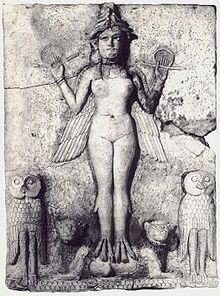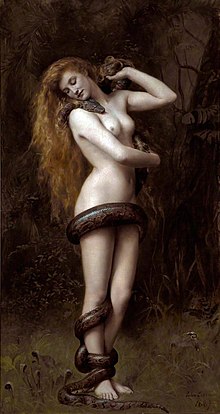| Revision as of 03:14, 19 July 2005 editDreamGuy (talk | contribs)33,601 edits note to warring editors: if you think I am wrong about proper capitalization, go read Misplaced Pages:Capitalization and educate yourself instead of reverting to bad version← Previous edit | Revision as of 03:18, 19 July 2005 edit undoGabrielsimon (talk | contribs)2,118 edits this title is how the Goddess Inanna was spoken ofNext edit → | ||
| Line 1: | Line 1: | ||
| ::''This article is about the demon Lilith. For other meanings of the word see ].'' | ::''This article is about the demon Lilith. For other meanings of the word see ].'' | ||
| ] | ] | ||
| '''Lilith''' is known as a ] night ] with a penchant for killing male children and sadistic sexual assaults on sleeping men. She is also sometimes thought of as the first wife of the Biblical ]. The Burney Relief, of ] or ] origin and dating from c. 1950 BC, had been commonly thought to depict her. Many believe there to be a connection between Lilith and ], Sumerian |
'''Lilith''' is known as a ] night ] with a penchant for killing male children and sadistic sexual assaults on sleeping men. She is also sometimes thought of as the first wife of the Biblical ]. The Burney Relief, of ] or ] origin and dating from c. 1950 BC, had been commonly thought to depict her. Many believe there to be a connection between Lilith and ], Sumerian Goddess of War and sexual pleasure. | ||
| ==Lilith in mythology== | ==Lilith in mythology== | ||
Revision as of 03:18, 19 July 2005
- This article is about the demon Lilith. For other meanings of the word see Lilith (disambiguation).

Lilith is known as a Mesopotamian night demoness with a penchant for killing male children and sadistic sexual assaults on sleeping men. She is also sometimes thought of as the first wife of the Biblical Adam. The Burney Relief, of Sumerian or Assyrian origin and dating from c. 1950 BC, had been commonly thought to depict her. Many believe there to be a connection between Lilith and Inanna, Sumerian Goddess of War and sexual pleasure.
Lilith in mythology
Various versions of the Lilith myth exist. Hieronymus associated Lilith with the mythical Greek Lamia, a Libyan queen who mated with Zeus. After Zeus abandoned Lamia, Hera stole Lamia's children, and Lamia took revenge by stealing other women's children.
Her original name in Akkadian was Lilitu, which means wind. In Akkadian mythology, she belonged to the same class of demons as Lilu, Ardat Lili, and Idlu Lili. The transliteration from the Hebrew is "לילית" may be as Lilith, Lillith, or Lilit.
Lilith in the Bible and other ancient texts
Lilith's name may be referenced within the Old Testament. Isaiah 34:14 says: "The wild beasts of the desert shall also meet with the wild beasts of the island, and the satyr shall cry to his fellow; the screech owl also shall rest there, and find for herself a place of rest." This is the only time the word Lilitu is used in Bible, and it is typically translated as screech owl. (See also Little Owl.)
However, some interpret the passage in Genesis 1:27 — "So God created man in his own image, in the image of God created he him; male and female created he them" — before describing a mate being made of Adam's rib and being called Eve in Genesis 2:22 to mean that Adam had a wife before Eve. This could have been Lilith. However, this divergence is often explained by the documentary hypothesis as a weaving together of two different creation myths, as the Bible describes man being created in both Genesis 1:26 and 2:7.
Lilith's name also appears in the Dead Sea Scrolls in passages based on the above-noted Isaiah reference as well as in various places in the Talmud and the Zohar.
Lilith as Adam's first wife
The origin of Adam and Lilith is not clear — as mentioned previously, only one explicit reference to her exists in the Bible. One medieval reference to Lilith as the first wife of Adam, The Alphabet of Ben-Sira, was authored anonymously. Lilith is described as refusing to assume a subservient role to Adam during sexual intercourse and so deserting him ("She said, 'I will not lie below,' and he said, 'I will not lie beneath you, but only on top. For you are fit only to be in the bottom position, while I am to be the superior one.'").
Lilith then went on to mate with Asmodai and various other demons she found beside the Red Sea, creating countless lilin. Adam urged God to bring Lilith back, so three angels were dispatched after her. When the angels, Senoy, Sansenoy, and Semangelof, made threats to kill one hundred of Lilith's demonic children for each day she stayed away, she countered that she would prey eternally upon the descendants of Adam and Eve, who could be saved only by invoking the names of the three angels. She did not return to Adam.

While this legend was included in an English language book of rabbinic works, The Alphabet of Ben-Sira is not a Jewish religious text; rather, it is a collection of stories about heroes of the Bible and Talmud. Modern historians are unsure of its original purpose, although it may have been a collection of risqué folk-tales; a refutation of Christian, Karaite, or other separatist movement; or simply an anti-Jewish satire.
However, the story has similarities with the original Mesopotamian myth, where Lilith killed children, and the Hebrew tradition of placing an amulet around the neck of newborn boys, inscribed with the names of three angels who are to protect them from the lilin until their circumcision, lends weight to the argument that Lilith had existed in earlier Hebrew mythology and is not the creation of later medieval authors. There is also a Hebrew tradition to wait a while before a boy's hair is cut so as to attempt to trick Lilith into thinking the child is girl so that the boy's life may be spared.
Connection to Unification Theology
The idea that a woman in the Garden of Eden used sex to dominate Adam resonates with the Unification theology of the Rev. Sun Myung Moon. The attributes of Lilith above are in some ways similar to those attributed to Eve by Unificationists:
- deserting Adam
- mating with a demon (Lucifer)
- refusing to assume a subservient role to Adam
Although Unificationists do not describe Eve as a murderer per se, their interpretation is that Eve caused the spiritual death of Adam. This led to the first (physical) murder in human society, when Cain killed Abel. Thus, Eve indirectly killed the male child, Abel.
Lilith in popular culture
See also
References
- An overview of the Lilith Mythos including analysis of the Burney Relief
- Kramer's Translation of the Gilgamesh Prologue. Kramer, Samuel Noah. "Gilgamesh and the Huluppu-Tree: A reconstructed Sumerian Text." Assyriological Studies of the Oriental Institute of the University of Chicago 10. Chicago: 1938.
External links
- International standard Bible Encyclopedia: Night-Monster
- Jewish Encyclopedia: Lilith
- A criticism of the Lilith myth in Jewish feminism